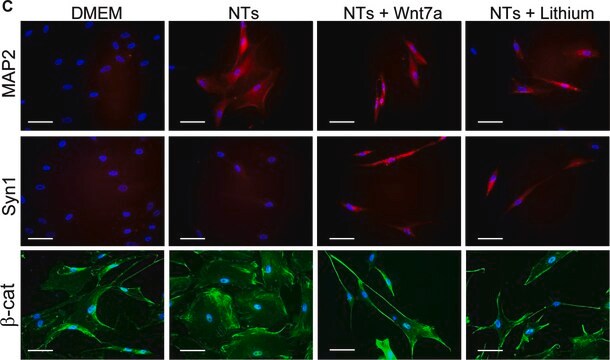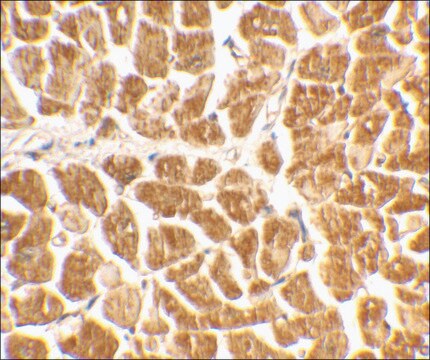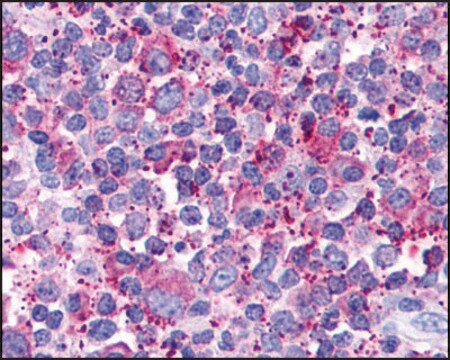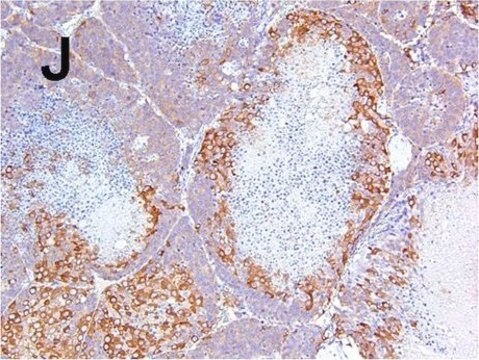AB5905
Anti-Vesicular Glutamate Transporter 1 Antibody
serum, Chemicon®
Synonim(y):
VGLUT1, BNPI
Zaloguj sięWyświetlanie cen organizacyjnych i kontraktowych
About This Item
Kod UNSPSC:
12352203
eCl@ss:
32160702
NACRES:
NA.41
Polecane produkty
pochodzenie biologiczne
guinea pig
Poziom jakości
forma przeciwciała
serum
rodzaj przeciwciała
primary antibodies
klon
polyclonal
reaktywność gatunkowa
rat
producent / nazwa handlowa
Chemicon®
metody
immunohistochemistry: suitable
numer dostępu NCBI
numer dostępu UniProt
Warunki transportu
dry ice
docelowa modyfikacja potranslacyjna
unmodified
informacje o genach
rat ... Slc17A7(116638)
Opis ogólny
Vesicular glutamate transporter 1 (VGLUT1) is encoded by the gene mapped to human chromosome 19q13. VGLUT1 is specifically expressed in neuronal cells in the brain. It is characterized with a conserved C-terminal dileucine-like motif and two polyproline domains distal to C- terminal end, including one that binds to endocytic BAR (Bin/Amphiphysin/Rvs) domain protein, endophilin.
Specyficzność
Recognizes Vesicular Glutamate Transporter 1 (VGLUT1, BNPI {Brain specific Na+ dependent inorganic phosphate cotransporter}). The antiserum has been tested on tissue sections from the rat central nervous system (CNS) using immunofluorescence histochemistry. The antiserum mainly labels nerve fibers and terminals. VGLUT1 is an excellent marker for glutamatergic nerve terminals. The staining pattern for the staining obtained with the VGLUT1 antiserum corresponds to the pattern described using other antisera to VGLUT1 (Bellocchio et al., 1998; Fremeau et al., 2001; Fujiyama et al., 2001; Sakata-Haga et al., 2001; Tong et al., 2001; Kaneko et al. 2002; Varoqui et al., 2002). Preabsorption of the VGLUT1 antiserum with immunogen peptide eliminates all immunostaining.
Immunogen
Synthetic peptide from rat VGLUT1 protein with no overlap to VGLUT2. The immunogen is available as AG208.
Zastosowanie
- Tested Applications
Immunocytochemistry Analysis: A 1:250 dilution from a representative lot detected Vesicular Glutamate Transporter 1 in rat E18 cortical cells. - Note: Actual optimal working dilutions must be determined by end user as specimens, and experimental conditions may vary with the end user
Opis wartości docelowych
62 kDa
Postać fizyczna
Guinea pig Serum in 0.1% Sodium Azide.
Informacje prawne
CHEMICON is a registered trademark of Merck KGaA, Darmstadt, Germany
This page may contain text that has been machine translated.
Nie możesz znaleźć właściwego produktu?
Wypróbuj nasz Narzędzie selektora produktów.
Kod klasy składowania
10 - Combustible liquids
Klasa zagrożenia wodnego (WGK)
WGK 1
Certyfikaty analizy (CoA)
Poszukaj Certyfikaty analizy (CoA), wpisując numer partii/serii produktów. Numery serii i partii można znaleźć na etykiecie produktu po słowach „seria” lub „partia”.
Masz już ten produkt?
Dokumenty związane z niedawno zakupionymi produktami zostały zamieszczone w Bibliotece dokumentów.
Klienci oglądali również te produkty
The regulation of corticofugal fiber targeting by retinal inputs
Grant E, et al.
Cerebral Cortex, 26(3), 1336-1348 (2016)
The expression of vesicular glutamate transporters defines two classes of excitatory synapse.
Fremeau, R T, et al.
Neuron, 31, 247-260 (2001)
Persistent zinc depletion in the mossy fiber terminals in the intrahippocampal kainate mouse model of mesial temporal lobe epilepsy.
Koichi Mitsuya, Naoki Nitta, Fumio Suzuki, Koichi Mitsuya, Naoki Nitta, Fumio Suzuki
Epilepsia null
N Rebola et al.
Neuroscience, 133(1), 79-83 (2005-05-17)
Adenosine is a neuromodulator that controls neurotransmitter release through inhibitory A1 and facilitatory A2A receptors. Although both adenosine receptor-mediated inhibition and facilitation of glutamate release have been observed, it is not clear whether both A1 and A2A receptors are located
Lentiviral delivery of a vesicular glutamate transporter 1 (VGLUT1)-targeting short hairpin RNA vector into the mouse hippocampus impairs cognition
King MV, et al.
Neuropsychopharmacology, 39(2), 464-476 (2014)
Nasz zespół naukowców ma doświadczenie we wszystkich obszarach badań, w tym w naukach przyrodniczych, materiałoznawstwie, syntezie chemicznej, chromatografii, analityce i wielu innych dziedzinach.
Skontaktuj się z zespołem ds. pomocy technicznej












